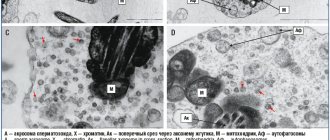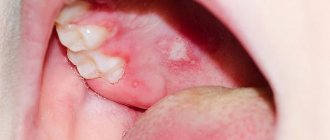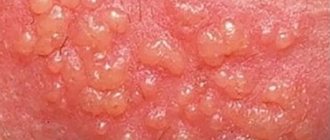Manifestations of the virus are characteristic blistering rashes on the mucous membranes and skin. After some time, small ulcers form in their place, then crusts. In the area where the rash should appear, burning and itching first occurs. Herpes is characterized by severe pain in the area of the rash.
The herpes virus spreads along the nerve endings and is not completely removed from the body even after a course of drug therapy. It is able to exist in an active and “sleeping” state.
Herpes simplex viruses types 2 and 1 are transmitted sexually and through contact, even when the symptoms of the disease in the carrier are not yet noticeable. In the early stages of infection, there are usually no symptoms at all, so diagnosis can only be made in the initial stages through laboratory testing. Primary infection with the virus most often occurs in childhood, even in preschool age.
In women, genital herpes usually appears on the labia and cervix, less often in the perineal area. In men, blisters appear on the skin and mucous membrane of the penis, as well as inside the urethra and rectum.
Why do tests for herpes simplex virus types 1 and 2?
Herpes simplex virus types 2 and 1 not only cause cosmetically unpleasant rashes. It also causes severe pain (for example, along the nerve trunks in the area of the rash), general weakness and damage to the central nervous system.
Therefore, it is important to know about the presence of this virus in the body in order to ensure the necessary prevention of exacerbations of infection and timely, comprehensive treatment. These measures will prevent complications associated with the active progression of herpes infection.
The danger of herpes simplex virus types 2 and 1 is that against the background of decreased immunity, from which no person is immune at different periods of life, the infection is activated. The activity of the virus can lead to serious complications such as damage to the facial, auditory and other cranial and spinal nerves.
Herpes simplex virus types 2 and 1 can seriously threaten a pregnant woman and her unborn child. Intrauterine infection occurs with serious consequences for the nervous system. Reactivation of the infection during pregnancy can lead to its pathological course or premature termination.
Symptoms
As a rule, symptoms appear only in young children or in adults with a pathology of the immune system, HIV-infected people taking medications that suppress the immune system. It can occur after serious illnesses, transplantation and other surgical interventions. Symptoms are quite extensive, but are more often expressed in fever and rash on the skin and mucous membranes.
Cytomegalovirus infection
- In the acquired form, the following is observed:
- Temperature increase.
- General malaise, weakness.
- Headache.
- Enlarged neck lymph nodes, sore throat.
Rarely, complications occur in the form of pneumonia, arthritis, and symptoms of hepatitis.
Congenital is expressed in the following symptoms:
- Hepatosplenomegaly is an enlargement of the spleen and liver.
- Microcephaly is a significant reduction in the size of the skull and, accordingly, the brain.
- Jaundice of the skin and sclera.
- Petechiae is a hemorrhagic rash that occurs due to damage to intradermal capillaries.
- Neurological abnormalities.
Infection with cytomegalovirus during pregnancy can lead to the death of the embryo and pathological damage to the fetus. These include hemorrhagic syndrome and damage to the nervous system. Sensorineural hearing loss and balance disorders are more common, and intellectual disorders, epilepsy, cerebral palsy, visual impairment, and microcephaly are less common.
Epstein–Barr virus
Primary infection is characterized by:
- Catarrhal sore throat.
- Nasal congestion.
- Enlarged lymph nodes.
- Moderate increase in lymphocytes.
Manifest form - infectious mononucleosis is accompanied by:
- fever;
- general malaise;
- headache;
- sore throat;
- enlarged cervical lymph nodes, pain;
- splenomegaly;
- hepatomegaly;
- jaundice.
Infectious mononucleosis:
- Heat.
- Headache.
- Inflammation of the pharynx and tonsils.
- Enlarged and painful lymph nodes.
- Enlarged liver and spleen.
In severe forms of the disease, complications may occur in the form of otitis media, sinusitis, hepatitis, peritonsillar abscess, and pneumonia.
Herpes virus HHV-6
It has a wide range of symptoms, with the following symptoms most often noted:
- temperature up to +40 °C;
- symptoms of intoxication;
- erythematous or papular rash;
- mild hyperemia of the pharynx.
If a person has a strong immune system, without pathologies, then HCH-6 is asymptomatic.
Herpes virus HHV-7
No symptoms identified. In persons with immunodeficiency, it can cause pseudorubella, fever, pityriasis rosea, convulsions, and chronic fatigue syndrome.
Herpes virus HHV-8 (HHV-8, Kaposi's sarcoma)
Clinical manifestations are observed only with immunosuppression. They are expressed in the appearance of vascular seals and form on the skin and in the mouth. These are multiple hemorrhagic neoplasms of a malignant nature. Over time, the virus can cause complications in the lungs, gall bladder, bile ducts and other internal organs.
When should you test for antibodies to herpes simplex?
It is advisable to carry out an analysis for antibodies to herpes simplex virus types 1 and 2 (IgG, IgM), as well as an analysis for the DNA of the virus in the following cases:
• If small blisters appear on the skin or mucous membranes;
• With HIV infection or immunodeficiency of unknown origin;
• The appearance of burning, swelling and rashes in the genitourinary area may indicate herpes simplex virus type 2. Determination of antibodies to herpes simplex virus type 2 IgG class and other methods can help in the differential diagnosis of genitourinary tract infections;
• In preparation for pregnancy (it is advisable for both partners to be tested for antibodies to herpes simplex);
• If there are signs of intrauterine infection of the child or feto-placental insufficiency, etc.
Treatment
Since the herpes virus is integrated into the genome of a human cell, it cannot be removed. Therapeutic measures are aimed at diseases caused by herpes viruses. For treatment, etiotropic drugs and means to relieve symptoms are prescribed. The choice of medications, dosage and method of treatment are chosen individually, based on the patient’s condition, the presence of complications and concomitant diseases.
Herpes viruses are activated against a background of suppressed immunity; most patients are HIV-infected. In this case, treatment is indicated in immunologically favorable conditions, in which case the risk of complications is lower and the chances of cure are higher. However, patients with a poor prognosis also undergo individual, not always systematic, treatment.
Diagnostics
Tests for antibodies to herpes simplex virus 2 and 1: IgG, IgM
Given the high frequency of infection, antibodies to the herpes simplex virus are found in the vast majority of people (more than 90%) around the world. However, the antibody titer and its change over a certain period can provide much more information important for the treatment of herpes simplex virus types 2 and 1.
Antibodies to herpes simplex Ig M and Ig A do not remain in the blood for long - approximately 1-2 months. The only type of antibodies to herpes simplex virus 1 and 2 that persist in the blood throughout life is IgG.
Antibodies to herpes simplex Ig M are markers of primary infection. During primary infection with herpes simplex virus types 2 and 1, the IgG titer may increase. If the tests were taken at an interval of 10-12 days, the titer of IgG antibodies to the herpes virus can increase fourfold.
In the case of recurrent infection, antibodies to herpes simplex virus 1 and 2 IgG are very high. This indicates constant antigenic stimulation of the body. The exacerbation of the disease is also indicated by the appearance of IgM in the blood serum.
Genital herpes in women
Infection occurs mainly through unprotected sexual contact with a sick man. Moreover, it is possible to get the virus through oral and anal sex. It is possible that the virus can be transferred by hands to the genitals.
If a woman has herpes, rashes are observed on:
- labia, groin area, buttocks;
- in the vestibule of the vagina;
- in the perineum;
- on the walls of the vagina, on the cervix;
- on the rectal mucosa.
Women become infected with herpes more often than men, since there are more accessible areas covered with mucous membrane. It is not necessary that the man have clinical manifestations of the disease in the form of rashes. The virus is found in semen and urine.
Herpes in women can cause early and late miscarriages and damage to the fetus during pregnancy.
Herpes of the bladder and urethral canal is also found. When the disease worsens, urination is very painful and bloody. May be accompanied by bladder pain and fever.
The pathological process may involve the mucous membrane of the rectum (cracks form), pain in the pelvis and in the area of the projection of the uterus, damage to the ovaries (symptoms of irritation of the pelvic nerve coupling). More often, such manifestations occur before or immediately after menstruation.
The nature of the disease is not always determined and recognized. Sometimes women are treated with antiviral and antibacterial drugs to no avail and for a long time.
Interpretation of tests for antibodies to herpes simplex virus types 1 and 2
• IgG is elevated in chronic herpes infection. If antibodies to herpes IgG increase by more than 30% when repeated testing after a time interval of 10 days, you can think about activation of the infection. If the titer of IgG antibodies to the herpes virus decreases during repeated studies, this indicates the success of treatment and the “extinction” of the infection.
Elevated IgG antibodies to herpes may indicate an intrauterine infection or the likelihood of its development. If the study was first performed during pregnancy, then it is not worth judging the probability until repeated studies are carried out. If IgG antibodies to herpes simplex virus types 2 and 1 were detected in the blood before pregnancy, then the likelihood of intrauterine infection is low.
• IgA appears in the blood 14 or more days after infection with the herpes virus and is not critical in diagnosis.
• IgM class - the first antibodies that appear after infection with herpes simplex virus types 2 and 1 within two weeks. A positive test result makes one think about an acute herpetic infection or the activation of a chronic one. In the latter case, IgM does not always appear in the blood serum; here the concentration of IgG antibodies to herpes is of greater importance.
A negative test result may indicate no infection. However, the same test result occurs in the first days of herpes infection or with a chronic inactive infection.
Recurrent herpes
In 50%-70% of people the disease becomes chronic. This is facilitated by:
- untimely or incorrect treatment;
- decreased immunity, including that caused by taking medications that suppress the immune system;
- presence of other STDs;
- strict diets, vitamin deficiencies;
- state of chronic stress.
Why do patients develop relapses, during which the disease affects the same parts of the body? There are several reasons for this:
- Having penetrated the body, the virus settles in the tissues of the genital organs. As it multiplies, it affects cells deeper and deeper until it reaches nerve cells - neurons connected to each other by processes - axons. Through them, like bridges, the pathogen reaches the cells of the spinal cord, into which it introduces its DNA.
- An infected brain cell becomes an “incubator” for viruses, which periodically return via axon bridges to the mucous membrane or skin, causing new rashes. Schematically, the process is similar to the migration of birds, constantly returning to their “native places.”
- The immune system cannot kill viruses hidden in the spinal cord, but it deals with those that have left the “shelter”. Therefore, with high immunity, relapses occur rarely or not at all. But as soon as the body “loses its vigilance” - weakens, gets sick, catches a cold, is exposed to stress - the pathogens begin to overcome the immune defense. As a result, they reach their target - the skin and mucous membranes of the genital organs. Here, the increased reproduction of viral particles inside the “captured” cells begins. Cellular structures, dying, release myriads of viruses that cause inflammation, redness, swelling and the appearance of blisters. Herpes is causing another aggravation.
- Gradually, the immune system fights back the virus, and within 10 days the ulcers at the site of the rash dry out and heal. Everything returns to normal, so that at the slightest weakening of the immune system it can start again.
From the mechanism of exacerbations, it becomes clear why herpetic eruptions appear in the same places. It’s just that the virus cells return back only through the nerve cell from which they penetrated deep into the body.
Types of recurrent herpes
Depending on the number of exacerbations, several types of the disease are distinguished:
- mild, occurring up to 3 times a year;
- moderate severity, in which exacerbations occur 4-6 times a year;
- severe, accompanied by frequent exacerbations, intervals between which do not exceed a month;
- arrhythmic, in which after a period of imaginary well-being, lasting from a month to five, rashes appear. This form of herpes is characterized by a pattern - the longer the remission, the more severe the disease;
- menstrual, manifested by rashes during menstrual periods. This type of disease is severe and difficult to treat;
- subsiding, in which the manifestations of the disease constantly become weaker, and the inter-relapse periods become longer. The subsidence of the manifestations of the disease indicates the positive dynamics of treatment and the restoration of immune defense that suppresses the virus.
Determination of DNA of herpes simplex virus types 1 and 2
The study is carried out using a highly sensitive PCR (polymerase chain reaction) technique. The DNA of the virus is determined by examining a scraping from the urethra, collecting morning urine or cerebrospinal fluid. If the analysis revealed DNA fragments of herpes simplex virus type 2 or 1, this indicates the presence of a herpes infection. If viral DNA is not detected, it means that it is not present in the sample taken, or is still present there in a concentration below the sensitivity limit of the test.
In Lab4U, using laboratory methods, you can accurately determine the presence of herpes simplex virus types 2 and 1, as well as get an impression of the course of the infectious process and possible complications. All this provides the doctor with valuable information that helps in diagnosis and choice of treatment regimen.
Types and routes of HSV infection
The content of the article
Herpes is a common infection that affects people of all ages. Most of those infected have already developed the disease in some way, and some people become virus carriers, spreading the disease. Infection with herpes occurs through sexual and household contacts, in utero or during childbirth from a sick mother, as well as through breast milk.
The herpes virus (HSV) remains in the human body for life, periodically being dormant (from a month to several years) or active, causing small rashes on the mucous membranes, which subsequently merge, forming crusty ulcers. With an extremely low level of immunity, a generalized form of herpes occurs with damage to internal organs.
There are 8 types of infection. The viruses are interrelated and can be detected simultaneously in one patient. Most often, two types of viruses are detected in humans:
- Type 1 virus - herpetic fever (oral herpes) - most often appears on the lips, but can also cause the genital form. Transmitted orally. The infection affects 67% of people.
- Type 2 virus - genital and anal herpes - the virus affects the genitals (genitals), causes herpes in newborns and the disseminated form - herpes zoster, spreading over the face and body. Transmitted sexually. 11% of people are infected.
The first type of herpes in most cases affects a person in preschool age, the second type - with the onset of sexual activity. The prevalence of household infection is extremely high, since the virus persists for a certain time on household items, door handles, and wet surfaces.
Which doctor treats genital herpes
Genital herpes is treated by a venereologist. A venereologist is a specialized specialist who deals with the treatment, diagnosis and prevention of sexually transmitted diseases. Herpes is a sexually transmitted disease, as it is transmitted primarily through sexual contact.
In our clinic, the venereologist has extensive experience and specialization in treating adults and children from genital herpes.
In case of existing complications of herpes, he can refer the patient for additional consultation with a neurologist, gastroenterologist, gynecologist, urologist, or proctologist.
A dermatologist, a doctor who treats diseases of the skin and mucous membranes, can also provide assistance. The dermatologist at our clinic has gained extensive experience in treating all major types of herpes.
Where to go for genital herpes
It is necessary to seek diagnosis and treatment of genital herpes at a specialized medical institution. Advantages of seeking help from our clinic:
- We accept appointments any day, seven days a week, which is very convenient for working citizens;
- There is a service to call a doctor at home (diagnosis, treatment, monitoring of recovery);
- an individual approach to each client is carried out;
- comfortable and favorable conditions for patients have been created;
- has its own laboratory to conduct the necessary laboratory and instrumental studies;
- doctors and all medical personnel work in a single team and jointly manage the patient, any issues during treatment are resolved, and if necessary, a medical council is created;
- always friendly attitude;
- confidentiality.
All clinic services are certified. We are responsible and provide guarantees. Calling a dermatologist to your home for genital herpes
In some cases, the patient cannot visit the clinic in person. Or for some reason he doesn’t want to do this. Our clinic offers a doctor's home call. You can contact us on any convenient day and discuss the doctor’s arrival time.
The service is popular due to a number of advantages:
- a doctor’s visit to your home is very convenient for people with limited mobility – pensioners, frail people, disabled people, blind people, post-operative people;
- Complete anonymity of treatment is maintained;
- at home, the doctor provides the same services as within the walls of the medical institution;
- all types of tests can be taken at home, they will be sent to the laboratory in special containers;
- a doctor at home can conduct instrumental diagnostics if necessary (ECG, ultrasound, x-ray);
- the doctor will talk about prevention methods, recommend what to do to avoid infecting household members through contact, and how to prevent relapse of the disease.
A doctor can come to your home on the same day of treatment.
Factors that provoke genital herpes
The virus does not manifest itself until the human body restrains it due to its protective forces - immunity. The trigger for the growth of the virus are factors such as:
- emotional and physical exhaustion;
- hypothermia;
- period;
- surgical interventions;
- infectious diseases.
There are cases where the provoking factor was ultraviolet exposure to sunlight.
With good immunity, the virus may not detect itself at all throughout life. In this case, the person acts as a virus carrier and is able to infect others.
How to prevent getting genital herpes
No one is immune from herpes infection. Most people get the virus in childhood - from their mother and other family members through kissing. This is the herpes simplex virus type 1. It was believed that it could not affect the genitals. However, practice has shown that such a development of events is possible.
It is impossible to prevent infection one hundred percent, but you can try to protect yourself by following a few rules:
- during pregnancy planning, undergo a full examination of the body for the presence of herpes of the first and second types;
- remain faithful to your sexual partner, do not have casual sexual contacts;
- in case of casual sexual intercourse, you should be examined for hidden infections;
- do not use other people’s lipsticks, manicure accessories, towels, or razors;
- wash hands after contact with rashes;
- monitor intimate hygiene;
- keep the bathroom clean:
- do not kiss a child on the lips, especially during an exacerbation of herpes on the lips.
You should take care of your health, increase your immunity through an active life and good nutrition, and give up bad habits.
Publication date 2019-11-10
Ointments for genital herpes
Ointments are always used to treat herpes. Some of the most effective are:
- Acyclovir
, it is prescribed most often, it quickly suppresses the reproduction of the virus, the rash goes away in a short time. - Valtrex
has approximately the same effect as Acyclovir. But it allows Acyclovir to remain in the body longer. Used in more complex situations. - Zovirax
is the same Acyclovir, only its original version. The mechanism of action of the drug is based on breaking the DNA helix of the virus. - Famvir
is a new drug. It is prescribed for recurrent herpetic infections, including in people who have reduced immunity. - Erazaban
. It has a unique antiviral effect, not only destroys the virus, but also prevents it from entering a healthy cell. The cream is applied to the rash, as well as to the area of skin around it. The product prevents the formation of bubbles if applied during the period of skin redness. - Virgan
is a special gel that is used for ophthalmoherpes. It disrupts the formation of viral hereditary material. Its action is similar to Acyclovir. - Oxolinic ointment
is an excellent antiviral agent. It is widely used, including for the fight against herpes. - Herpferon ointment
can be used both for the treatment and prevention of genital herpes. This ointment contains acyclovir, an antiviral agent, as well as interferon, an antiviral protein, the deficiency of which is believed to lead to relapses of the disease.
Creams and ointments are best used at the first manifestations of herpes - at the stage of formation of redness and swelling, when the rash has not yet formed.
Do not touch herpes rashes with your hands. Otherwise, it’s easy to spread the virus into your eyes later.
There will be a risk of severe damage to the cornea. If immunity is greatly reduced, then ophthalmoherpes can cause herpetic encephalitis with a high probability of death.
Diagnosis of sexually transmitted diseases:
- Calling a venereologist to your home
- Diagnosis of sexually transmitted diseases
- Prevention of casual sex
- Urethral swab
- Cervical smear
- Anal swab
- Vaginal smear
- Sexually transmitted diseases
- Tests for STIs
- Mushroom tests
- Diagnosis of prostate diseases
- Prostate massage
- Treatment of sexually transmitted diseases
- Diagnosis of scrotal diseases
- Testing for STIs at home
- Ultrasound of the prostate
- Ultrasound of the penis
- Tests for syphilis
- Make an appointment with a venereologist






